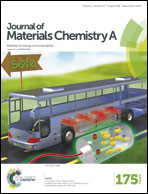Fabrication of high performance oxygen sensors using multilayer oxides with high interfacial conductivity†
Abstract
The effective enhancement of the ionic conductivity of solid oxide electrolytes by manipulating the multilayered hetero-nanostructures has been recognized for more than a decade; however, such fantastic nanostructures have not been applied for practical applications yet. Here we fabricated Ce0.8Sm0.1Nd0.1O2−δ/Al2O3 (SNDC/AO) multilayered electrolyte materials with high oxygen ionic conductivity and explored their applications in oxygen sensors with low operating temperature. The multilayer oxide electrolytes show a conductivity of 2 orders of magnitude higher than that of traditional yttria-stabilized zirconia (YSZ) ceramics at 400 °C, which endows the sensors with high performances including a rapid response (∼0.1 s), high sensibility (down to 1 vol%) and high cycling stability (no performance degradation after 1000 cycles), and most importantly, low operating temperature (200 °C lower relative to YSZ-based sensors). The excellent performances of our multilayered electrolytes can be attributed to their high interfacial conductivity and low activation energy which might be related to the highly disordered microstructures. This study shows good prospects for the efficient and practical use of multilayered oxide-based electrolytes for a range of applications including sensors, oxygen separation, solid oxide fuel cells (SOFCs) and solid oxide electrolysis cells (SOECs).


 Please wait while we load your content...
Please wait while we load your content...